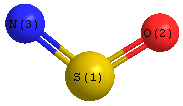Vibrational Frequencies calculated at B2PLYP=FULL/cc-pVTZ
| Mode Number |
Symmetry |
Frequency
(cm-1) |
Scaled Frequency
(cm-1) |
IR Intensities
(km mol-1) |
Raman Act
(Å4/u) |
Dep P |
Dep U |
|---|
| 1 |
A' |
1275 |
1219 |
19.38 |
5.26 |
0.70 |
0.82 |
| 2 |
A' |
1155 |
1104 |
94.33 |
12.21 |
0.47 |
0.64 |
| 3 |
A' |
304 |
291 |
33.37 |
7.38 |
0.31 |
0.48 |
Unscaled Zero Point Vibrational Energy (zpe) 1366.9 cm
-1
Scaled (by 0.9558) Zero Point Vibrational Energy (zpe) 1306.5 cm
-1
See section
III.C.1 List or set vibrational scaling factors
to change the scale factors used here.
See section
III.C.2
Calculate a vibrational scaling factor for a given set of molecules
to determine the least squares best scaling factor.
